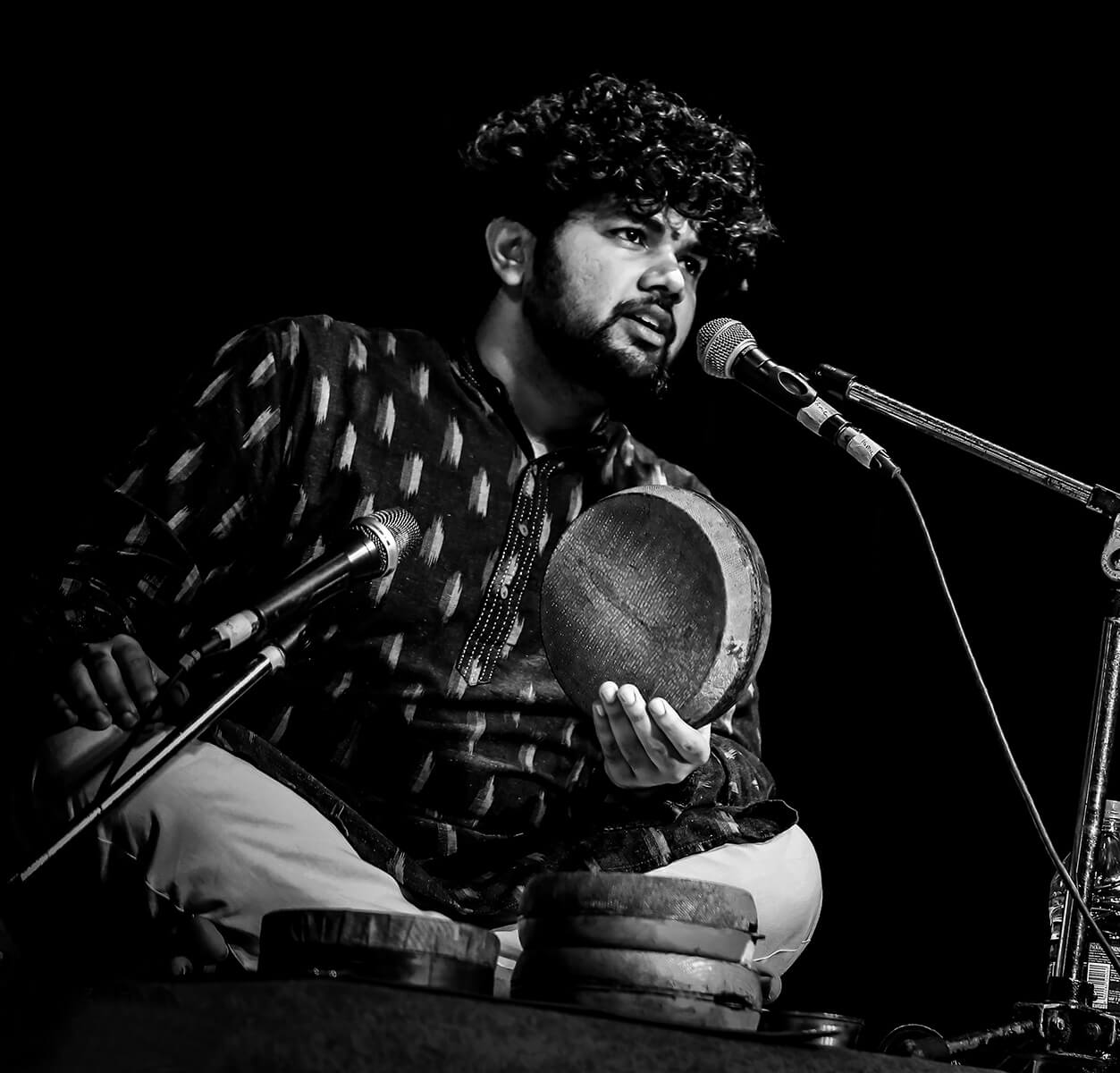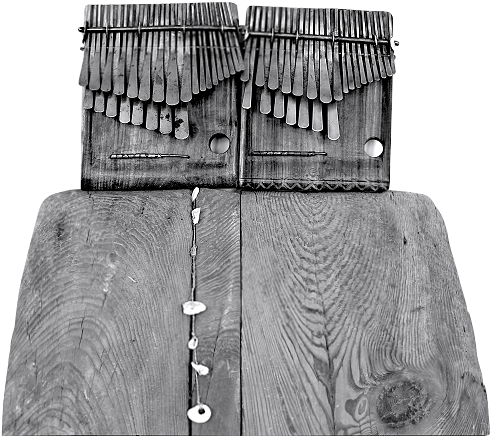
SUNAAD ANOOR
South Indian percussion & konnakol (India)
EDUCATION
MS in Mass Communication, Jain Universitiy, Bangalore.
GURUS / TEACHERS
Learning Mridangam and Kanjira from his father Vidwan Sri Anoor Dattatreya Sharma, his uncle Vidwan Sri Anoor Anantha Krishna Sharma.
Sunaad Anoor is born into a family of renowned musicians from Bangalore India. He is the 5th generation musician from his family. His great great grandfather and his great grandfather were proficient Veena Players. His grandfather was a very well known violinist in the country and his father and uncle are percussionists and his mother is a classical Indian vocalist.
With this background, there was nothing but music running at his home. Sunaad learnt violin for a few years but was very much inclined towards percussion. He parallel started to learn the percussion instrument Mridangam from his father Vid. Anoor Dattatreya Sharma. He was fascinated by the Kanjira when his cousin Vinod Shyam Anoor showed some of the techniques to play this instrument and asked him to play it in a concert soon after. That was when Sunaad was really inspired to take it up and practice it! He then continued his advanced studies in Indian Rhythms with his uncle Vid. Anoor Anantha Krishna Sharma. He observed all the masters of Kanjira and got inspired and practiced it until today. He has played kanjira as a solo and as accompaniment in more than a 1000 of concerts from the past 11 years. Sunaad has worked with many symphonies, ensembles, film scores in different genres of music.
His music has the core foundation of Indian Karnatic music but is also influenced by genres like, Hindusthani, Jazz, Latin and folk music. He is known for is spontaneous playing on stage and has a sound of his own which has developed in these years. He has performed all over India with very eminent Musicians from India! He has also performed in Germany and Singapore.
FESTIVALS & COLLABORATIONS
He has performed in 2018 with the ”Amithias Project” and the HR Big Band in Frankfurt Germany, directed by ‘Matthias Schreifl” on trumpet.
INTERNATIONAL MUSICIANS
He has collaborated with TeaTime Company (NL), Sjahin During, Matthias Schreifl, Sarah Buechi, Lars Andreas Haug, Sebastian Merk, Alex Morsey, Hami Keivan, Apoorva Krishna, Jurek Maczynski, Amith Nadig, Varijashree and more.
INDIAN MUSICIANS HE HAS WORKED WITH
Sunaad has performed with many Stalwarts of Carnatic Music like Vid. RK Srikantan, Vid. S. Shankar, Vid. MS Sheela, Vid, TS Sathyavathi, Vid. R A Ramamani, Vid. DV Nagaraj, Vid. Anoor Anantha Krishna Sharma, Vid. R Vishweshwaran(Veena), Vid, OS Thyagarajan, Vid. Suma Sudhindra, Vid. RK Padmanabha, Vid, Trichur Ramachandran, Vid, Maharajapuram Ramachandran, Vid. Kanyakumari, Mysore Brothers (Vid. Nagaraj and Vid. Manjunath), Vid. Kumaresh(Violin), Porur Brothers (Vid. MA Sundareshan and Vid. MA Krishnaswamy), Malladi Brothers (Vid. Malladi Ravikumar and Vid. Malladi Sreeramprasad), Vid. Sudha Raghunathan, Vid. MK Pranesh, Vid, Sriram Parashuram, Vid. Kalavathy Avadhoot, Vid. HK Venkatram, Vid. TS Krishnamurthy, Vid. Pattabhi Ramapandith, Vid. Shashank Subramaniam, Vid. Saketh Raman to name some.
Have performed with many Star Mridangam Artists like Vid. AV Anand, Vid. TAS Mani, Vid. Thiruvarur Bhakthavatsalam, Vid. Mannargudi Easwaran, Vid. Anoor Dattathreya Sharma, Vid. Anoor Anantha Krishna Sharma, Vid. HS Sudhindra, Vid. Arjun Kumar, Vid. Bangalore Praveen, Vid. Patri Satish Kumar, Vid. KU Jayachandra Rao, Vid. KV Prasad, Vid. Tumkur Ravishankar, Vid. Nyveli Narayanan, Vid. R Shankarnarayanan, Vid. V Krishna to name a few. Have also collaborated with Hindusthani Musicians like Pt. Pravin Godkhindi, Ustad Fayaz Khan, Pt. Ravindra Yavagal, Pt. Udayraj Karpoor, Ustad Rafiq Khan and many more.
Have collaborated in many Fusion Music and Cross-cultural Concerts/Projects. Have been a part of many Musical Ensembles, Symphonies, Orchestras and Dance Projects. Have recorded for film scores, classical albums and music videos.
Is an active member of a Powerful Percussion Ensemble “LayaLavayna” and a Fusion Band “Kalarava”. LayaLavanya’s latest venture the “Patra Naada Vaibhava” has been big hit across the state where we do not use any musical instrument! Have been a part of one of the oldest Percussion Ensembles in India called “LayaLahari”. With an absolute passion for rhythms and percussion, he has also performed with Percussion Instruments like Mridangam, Ghatam, Drums, Cajon and etc in many concerts.
AWARDS AND RECOGNITIONS
Has been awarded 1st place in the All India Radio(AIR) competition 2012 for Khanjira. Is currently an A graded artist of AIR and Doordarshan.
Has been awarded the prestigious ITC – Sangeet Research Academy Award in Mumbai.
Has been awarded TA Harihara Sharma Award from Krishna Gana Sabha, Chennai.
Has won the KFAC kalavanta-2015 award.
Has been ranked one among the Top 10 Karnatic Musicians from a Musical Blog called Humming Heart.
Has been Featured in Urban Ladder’s venture “Let’s Create”.
Besides Kanjira, Sunaad also masters konnakol, mridangam and drumset.
The art of Kanjira playing, konnakal and Carnatic music and how to integrate and translate it in various non Indian musical genres.
All about the fascination of the Kanjira – the smallest frame drum of the world – Sunaad Anoor introduces us into the highly profound South Indian rhythm system that is going back 5000 years and fathoms rhythmic incidents by means of syllable language and clapping techniques among others. The Tala system combines voice and coordination of movement so that a profound access to pulse and rhythm can be found. About konnakol (vocal percussion): A 5000 years old system and the only rhythmical language developed in the musical world. Highly complicated, rich and complete. A perfect balance between the intuitive and the mathematical rhythmical matrix.
KANJIRA
Kanjira is an amazing tambourine, the smallest frame drum of the world, full of power and grace. Coming out of South India, this small tambourine is filled with possibilities beyond its carnatic roots and has begun to grow in popularity around the world. Though there are many drums from India that date back centuries, this drum is relatively new to the scene and yet we are already seeing star players coming out who are specializing only in kanjira.
Bar none, the finest kanjira player in the history of the instrument so far is the great late G. Harishankar Rao, who popularized the instrument with his amazing technique and stylings. Through the kanjira a highly profound South Indian rhythm system is introduced, that is going back 5000 years and fathoms rhythmic incidents by means of syllable language and clapping techniques among others. The Tala system combines voice and coordination of movement so that a profound access to pulse and rhythm can be found.
KONNAKKOL
The universal rhythm language, Konnakkol is an ancient Indian rhythmic language. It is the art of reciting Carnatic Percussion Syllables. It may be performed as a Solo on stage or can be effective accompaniment to Vocal or Instrumental recitals. It has been widely used for many years, to learn & expertise other percussion instruments of Indian Classical Music. It is the most appealing art form equally attracting musicians, music lovers & common man. The term Konnakkol has only colloquial references as vocal percussion, all along Indian history. Konnakol has established itself to a universal rhythm language. It enhances our feel for time, pulse and groove and enables us to vocalise and memorise rhythmic phrases of high complexity. Musicians and dancers all over the world use konnakol to share musical ideas. One doesn’t even need a musical instrument to practice or perform konnakol. You can practically recite the syllables anywhere – on the train, walking in the park or lying at the beach.
Konnakol is the spoken reference to all South-Indian drums. A 5000 years old system and the only rhythmical language developed in the musical world. Highly complicated, rich and complete.
TALA
Tala means ”clap, tapping one’s hand on one’s arm, a musical measure in Sanskrit, in the music of India, Bangladesh, and Pakistan, a metric cycle with a specific number of beats—from 3 to 128—that recur in the same pattern throughout a musical performance. Tala might generally be equated with rhythm or metre, although the tala procedure has no precise counterpart in Western music. The concept of tala is found in rather different forms in northern Hindustani and southern Karnatak Indian music. In the north, beats appear in groups of two, three, or four and include strong as well as “empty” beats. The character of the beats and their subdivisions is represented by rhythmic syllables that are recited for practice and sometimes in performance; these syllables correspond to various types of strokes with the finger on the appropriate drum. Southern Indian talas consist of units of one (anudrutam), two (drutam), and three to seven (laghu) beats.
